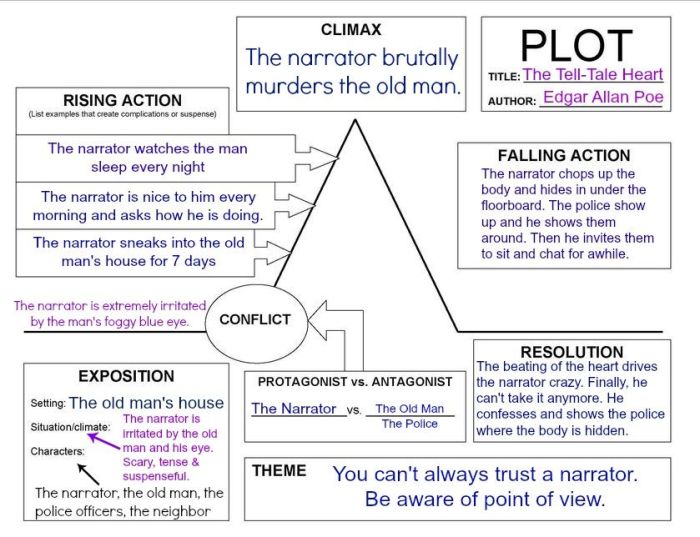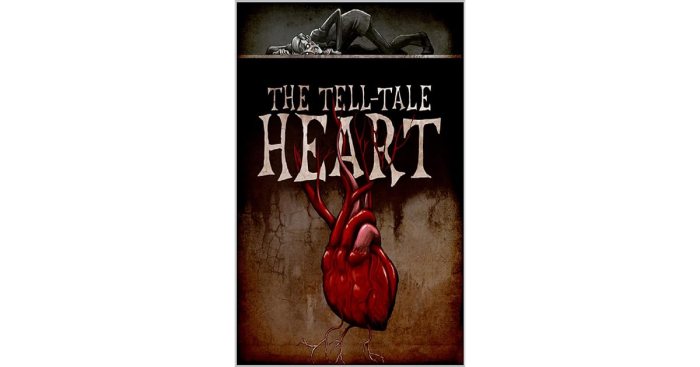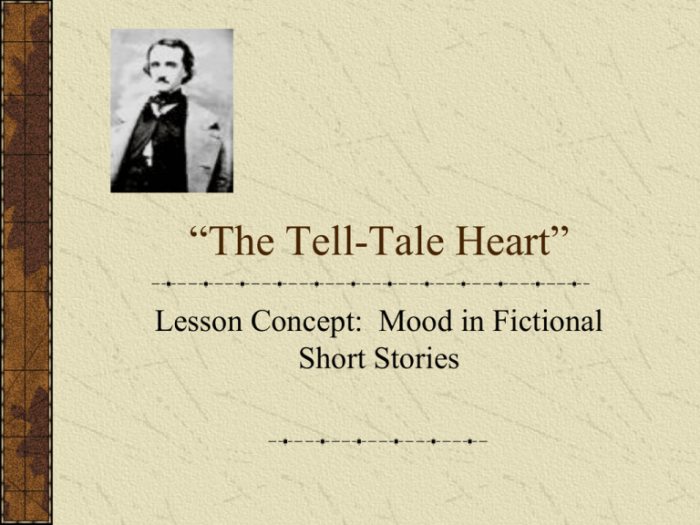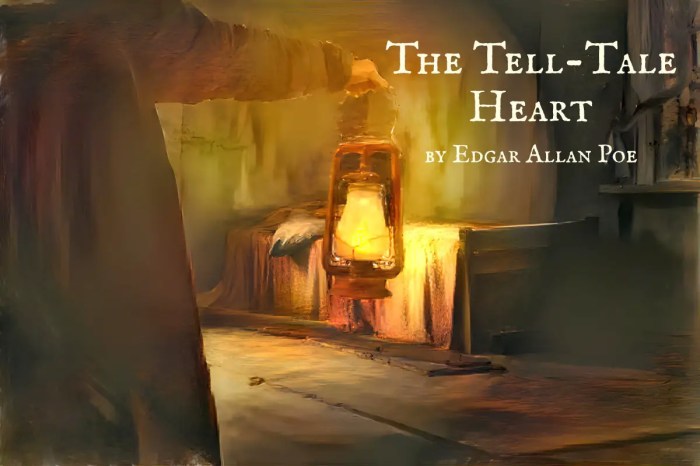The tell tale heart annotated – The Tell-Tale Heart Annotated unveils the intricate tapestry of Edgar Allan Poe’s classic tale, offering readers an immersive experience into the depths of a deranged mind. With meticulous annotations and insightful analysis, this edition delves into the story’s haunting atmosphere, complex characters, and enduring legacy.
As the narrator’s obsession with the old man’s “vulture eye” spirals into a terrifying crescendo, readers are drawn into a labyrinth of madness, guilt, and paranoia. Poe’s masterful use of symbolism, imagery, and foreshadowing weaves a chilling narrative that has captivated generations of readers.
Story Overview: The Tell Tale Heart Annotated
“The Tell-Tale Heart” is a classic short story by Edgar Allan Poe. It follows the narrator, an unnamed man who becomes increasingly obsessed with the “vulture eye” of an old man who lives next door. The narrator’s obsession leads him to murder the old man and ultimately confess his crime.
The narrator’s obsession with the old man’s eye is driven by a combination of fear and hatred. He claims that the eye is “evil” and that it fills him with a sense of dread. As his obsession grows, the narrator becomes increasingly agitated and paranoid, convinced that the old man is watching him and planning to harm him.
Character Analysis

The unnamed narrator of “The Tell-Tale Heart” is a complex and enigmatic character. His paranoia, guilt, and madness drive the story’s events and create a sense of unease and suspense.
The narrator’s paranoia is evident from the very beginning of the story. He is convinced that the old man’s “vulture eye” is watching him constantly, and he becomes increasingly agitated and fearful as the story progresses. This paranoia is unfounded, as there is no evidence that the old man is actually watching him.
However, it is a manifestation of the narrator’s own guilty conscience and his fear of being discovered.
The Tell-Tale Heart Annotated offers a fresh perspective on the classic short story. However, if you’re looking for a different kind of challenge, the Big Ideas Math Algebra 2 Book provides a comprehensive and engaging approach to algebra. Returning to the Tell-Tale Heart Annotated, this edition includes detailed annotations and analysis that delve deeper into the story’s themes and literary devices.
The narrator’s guilt is also a major factor in his mental state. He has committed a terrible crime, and he is unable to escape the guilt that consumes him. This guilt manifests itself in the narrator’s hallucinations and delusions, and it ultimately leads to his downfall.
The narrator’s madness is the most striking aspect of his character. He is clearly not in touch with reality, and his perceptions are distorted by his paranoia and guilt. This madness is evident in his obsession with the old man’s eye, his hallucinations of the old man’s heartbeat, and his inability to control his own thoughts and actions.
The Old Man’s Eye
The old man’s eye is a powerful symbol in the story. It represents the narrator’s paranoia and guilt, and it is the catalyst for his madness. The narrator’s obsession with the old man’s eye is a manifestation of his own guilty conscience and his fear of being discovered.
He believes that the old man’s eye is watching him constantly, and this belief drives him to commit the murder.
The old man’s eye is also a symbol of the narrator’s own mortality. The narrator is afraid of death, and he sees the old man’s eye as a reminder of his own mortality. This fear of death is a major factor in the narrator’s madness, and it ultimately leads to his downfall.
Symbolism and Imagery

Edgar Allan Poe masterfully employs symbolism and imagery to create an eerie and unsettling atmosphere in “The Tell-Tale Heart.” These elements enhance the psychological depth of the story, adding layers of meaning and evoking a sense of dread and paranoia.
The Beating Heart
The beating heart serves as a central symbol of the narrator’s guilt and fear. Its relentless pounding echoes his growing anxiety and the weight of his crime. The heart’s physical manifestation represents the psychological torment that consumes the narrator, driving him to madness.
Light and Darkness
The story alternates between moments of light and darkness, reflecting the narrator’s fluctuating mental state. The initial setting is dark and shadowy, reflecting the narrator’s secrecy and the sinister nature of his crime. As the story progresses, the narrator experiences moments of lucidity and guilt, symbolized by brief flashes of light.
However, these moments are fleeting, and darkness ultimately envelops the narrator, representing his descent into madness.
Literary Techniques

The Tell-Tale Heart employs a range of literary techniques to create a compelling and suspenseful narrative.
Foreshadowing
Foreshadowing is a literary device that hints at events to come, creating a sense of anticipation and unease in the reader. In The Tell-Tale Heart, the narrator’s obsession with the old man’s “vulture eye” foreshadows the gruesome act he will eventually commit.
Irony and Suspense
Irony is used to create a sense of tension and suspense in the story. The narrator’s belief that he has concealed his crime perfectly is ironic, as the reader knows that his guilt is evident in his every word and action.
The suspense builds as the narrator’s madness intensifies and the reader anticipates the inevitable discovery of his crime.
Historical and Cultural Context

Edgar Allan Poe wrote “The Tell-Tale Heart” in 1843, during a time of significant social and cultural change in the United States.
The story reflects the growing fascination with the macabre and the supernatural that was prevalent in the Romantic era. This era emphasized emotion, imagination, and the individual experience, and writers like Poe explored the darker side of human nature through their works.
American Gothic Literature, The tell tale heart annotated
The story also draws on the emerging genre of American Gothic literature, which combined elements of horror, mystery, and the supernatural with a focus on the psychological state of its characters. Poe’s use of an unreliable narrator and the exploration of madness and guilt are characteristic of this genre.
Critical Reception

Edgar Allan Poe’s “The Tell-Tale Heart” has garnered significant critical acclaim and sparked diverse interpretations since its publication in 1843. The story’s psychological depth and masterful use of language have captivated readers and critics alike.
One of the most striking aspects of “The Tell-Tale Heart” is its ambiguity. The narrator’s unreliable and fragmented perspective raises questions about his sanity and the reliability of his account. Critics have proposed various interpretations of the story, ranging from psychological to allegorical.
Psychological Interpretations
- Many critics have interpreted “The Tell-Tale Heart” as a psychological study of madness. The narrator’s obsessive preoccupation with the old man’s “vulture eye” and his growing paranoia suggest a deteriorating mental state.
- Some critics have also seen the story as a reflection of Poe’s own struggles with mental illness. Poe’s personal experiences with depression and addiction may have influenced the creation of the narrator’s disturbed psyche.
Allegorical Interpretations
- In addition to psychological interpretations, “The Tell-Tale Heart” has also been interpreted as an allegory. Some critics have suggested that the story represents the struggle between good and evil, with the narrator’s guilt and remorse symbolizing the consequences of sin.
- Others have seen the story as a commentary on the dangers of repression and the importance of confronting one’s fears. The narrator’s refusal to acknowledge his guilt ultimately leads to his downfall.
FAQ Explained
What is the significance of the old man’s eye?
The old man’s “vulture eye” becomes a symbol of the narrator’s growing paranoia and obsession, representing the guilt and fear that consume him.
How does the narrator’s madness manifest itself?
The narrator’s madness manifests through his increasingly erratic behavior, delusions of persecution, and hallucinations, leading him to commit the gruesome murder.
What literary techniques does Poe employ in “The Tell-Tale Heart”?
Poe uses foreshadowing, irony, and suspense to create a sense of unease and tension throughout the story, culminating in the narrator’s chilling confession.
